How to install the app on iOS
Follow along with the video below to see how to install our site as a web app on your home screen.
Note: This feature may not be available in some browsers.
You are using an out of date browser. It may not display this or other websites correctly.
You should upgrade or use an alternative browser.
You should upgrade or use an alternative browser.
Lahore now the cleanest big city in Pakistan, and greener too. New imagery here!!
- Thread starter N.Siddiqui
- Start date
AZADPAKISTAN2009
ELITE MEMBER

- Joined
- Sep 8, 2009
- Messages
- 37,662
- Reaction score
- 68
- Country
- Location
Nice copy  should have match the height 100%
should have match the height 100%
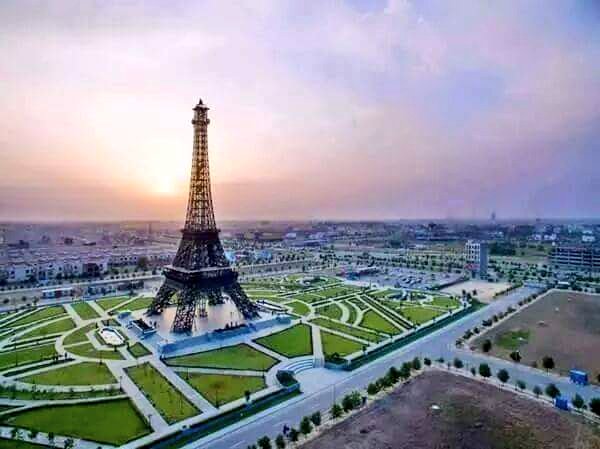
Quite lovely wondeful sights


Lovely images , this spirt has to be replicate in all cities of Pakistan must visit this city of Lahore
 should have match the height 100%
should have match the height 100%
Quite lovely wondeful sights


Lovely images , this spirt has to be replicate in all cities of Pakistan must visit this city of Lahore
Last edited:
Thanatos
FULL MEMBER

- Joined
- Dec 14, 2008
- Messages
- 681
- Reaction score
- 1
- Country
- Location
Even the proportion of population with figures, there is no match....
Bangalore population is almost 10 million vs 200 million pakistan population.You can compare export figure
Gujarat population is almost 65 million vs 200 million pakistan population.You can compare electricity production.
By the way Gujarat is not the largest electricity producer in India, so to know the scale of difference.
India is having many major airports where pakistan having few, still almost 55 million passengers travel every year vs 16 million passengers of all pakistan airports combined.
and the list going....
What are you comparing? Apples & oranges. Why dont you compare Bihar ( 100 milllion population) or UP or asam with Pakistan? Just cherry picked , Self serving , selective distortion of facts figures is what india is all about.
But if it makes you happy, keep it up. Staying in denial all the time.
N.Siddiqui
ELITE MEMBER

- Joined
- Nov 21, 2015
- Messages
- 9,708
- Reaction score
- 13
- Country
- Location
Gaddafi sports complex



In Gulberg






Botanical gardens

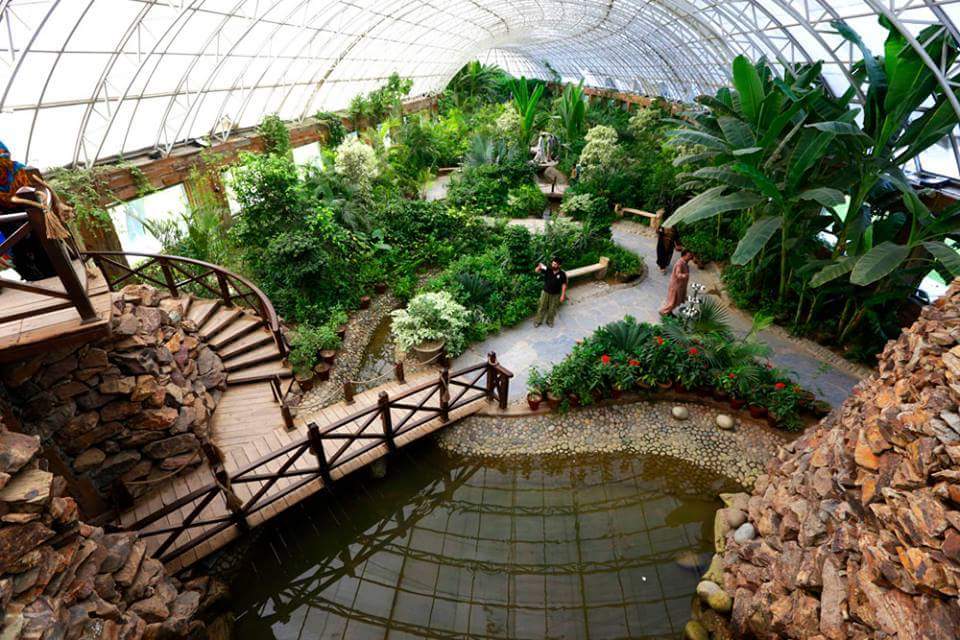







Liberty




In Gulberg






Botanical gardens









Liberty

N.Siddiqui
ELITE MEMBER

- Joined
- Nov 21, 2015
- Messages
- 9,708
- Reaction score
- 13
- Country
- Location



Univ. of Lahore







N.Siddiqui
ELITE MEMBER

- Joined
- Nov 21, 2015
- Messages
- 9,708
- Reaction score
- 13
- Country
- Location





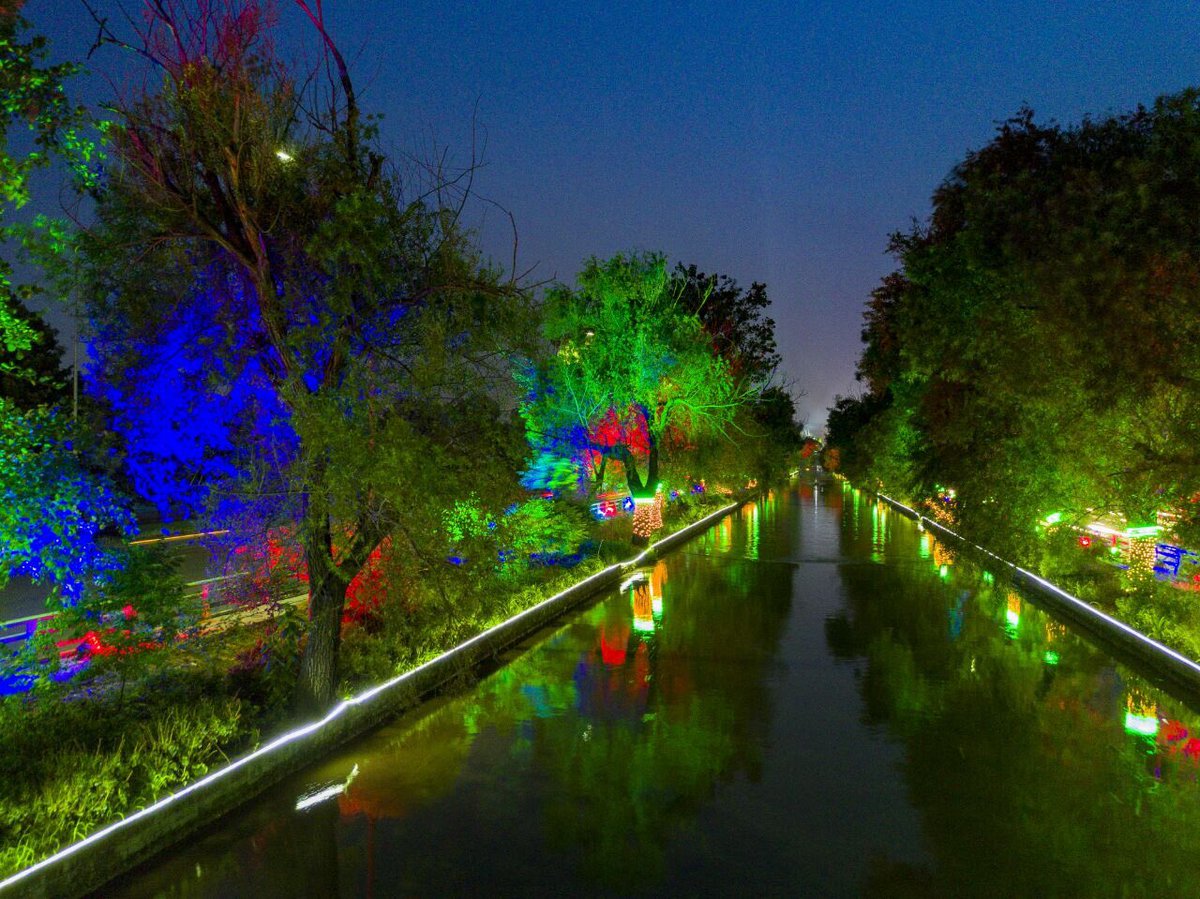
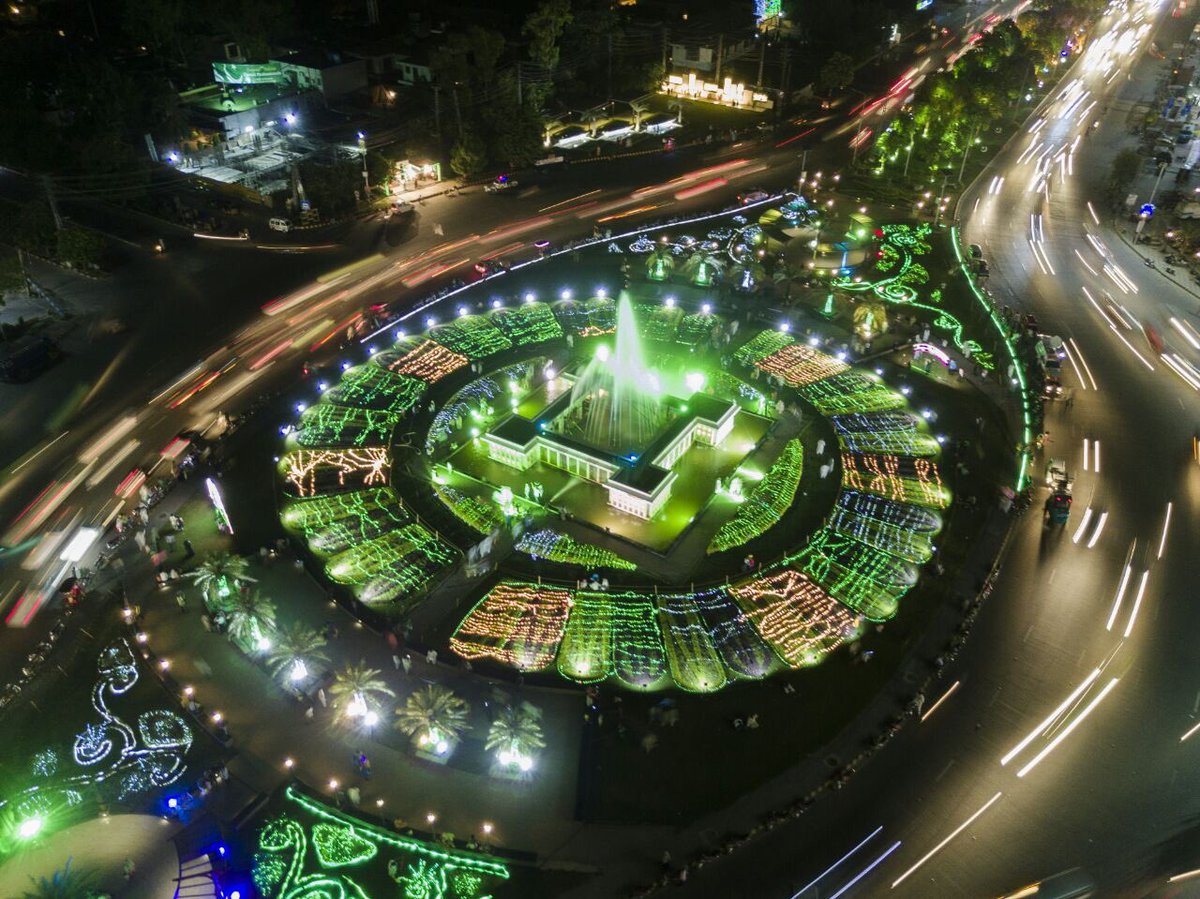



Model Town park

Walled city restoration and revival.









N.Siddiqui
ELITE MEMBER

- Joined
- Nov 21, 2015
- Messages
- 9,708
- Reaction score
- 13
- Country
- Location
Lahore walled city restoration and revival.

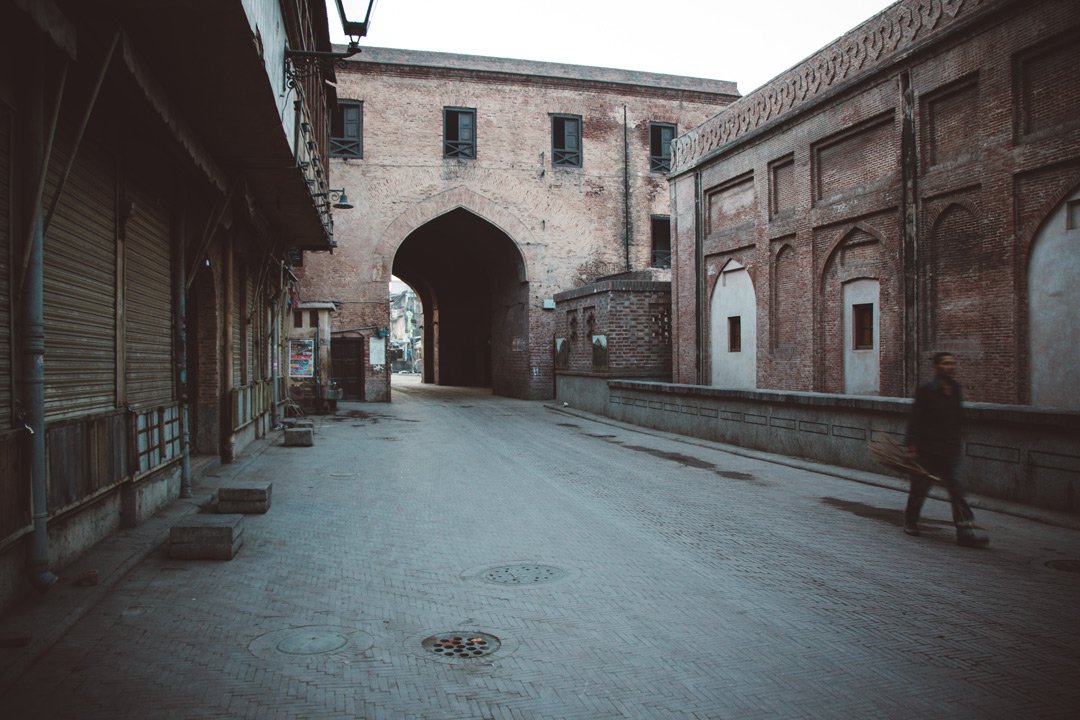


LAHORE | Sustainable Development of Walled City | Dilkash Lahore

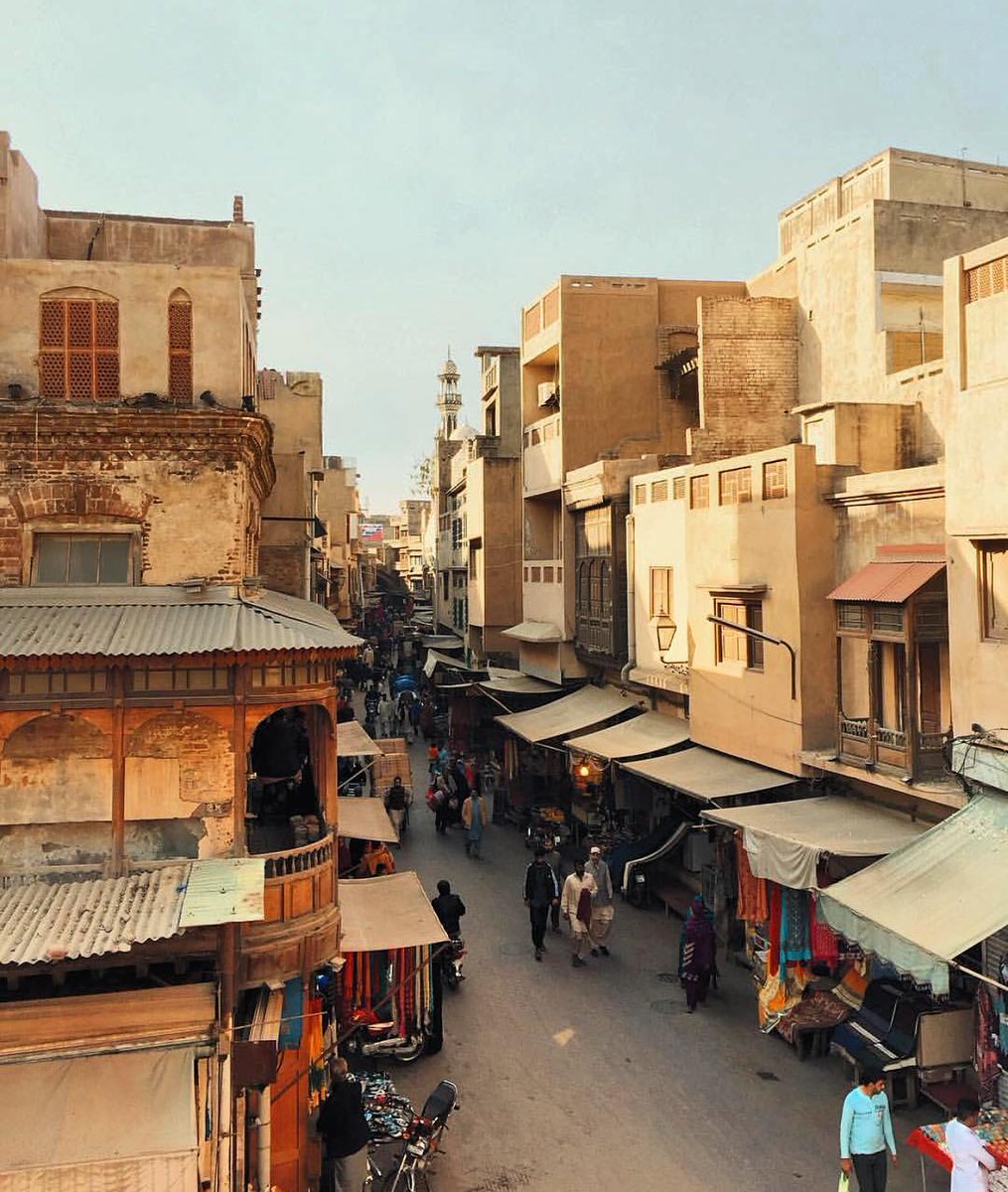
Shahi Hammam



A monument-al task

Masjid Wazir Khan is a jewel of Mughal architecture. It has retained its grandeur even after the passage of around four centuries since it was built between 1635 and 1640AD under the orders of Hakim Ilm ud Din, the then prime minister of King Shah Jahan. Over time, the magnificent structure has weathered many storms and seen its surrounding land, the forecourt in front of the eastern façade as well as the lower parts of its boundary walls devoured by encroachments.
Till recently, the situation was so bad that the constructions around the mosque became an eyesore, making it look like a structure totally out of place. The sight of the surrounding residential buildings and shops, motor workshops, and welding facilities right next to its boundary walls, was so overwhelming that the mosque would appear subdued in comparison.


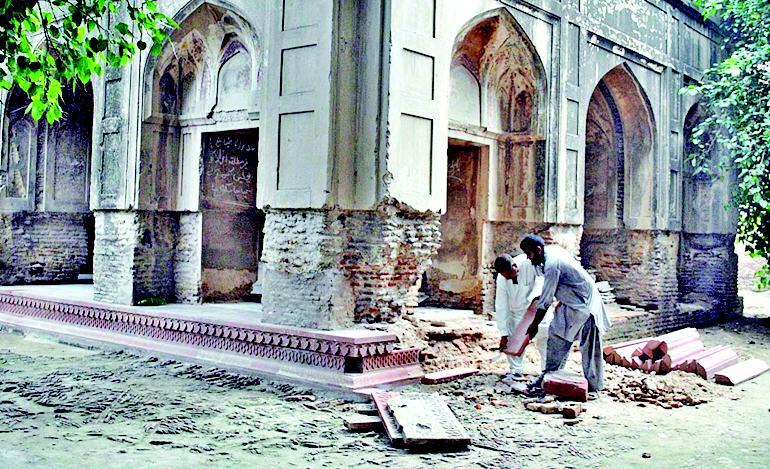


The walled city project is a public private partnership between punjab govt. and aga khan trust for culture (AKTC). AKTC has done numerous such projects all over the world. much of the credit goes to AKTC. punjab govt got the funds from world bank but the expertise and quality of work was provided by AKTC.
http://www.akdn.org/press-release/la...een-government
Ten-fold increase in foreign tourists for Lahore Walled City
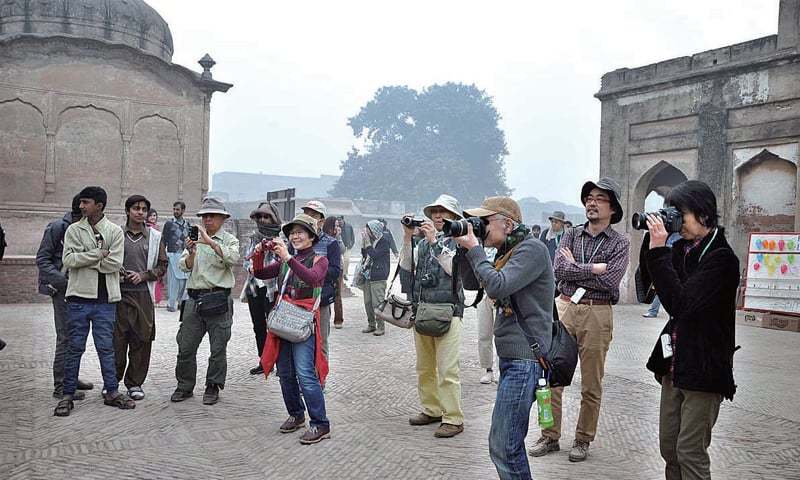
LAHORE: At least 51,647 tourists, including 2,350 foreigners, visited the Royal Trail inside Delhi Gate and other parts of the Lahore Walled City during 2015.
“A marked increase of nine to ten-fold of foreign tourists to the city has been recorded during the last four to five years,” said Shahid Nadeem, the Director Administration of the Walled City of Lahore Authority (WCLA).
The tourists visited there by foot and Rangeela Rickshaw and also availed themselves of the Tonga Service, according to a spokesperson of the WCLA.
The package-I for the restoration of several buildings and streets from Delhi gate to Purani Kotwali Chowk was completed in which the façade and infrastructure improvements of the Royal Trail were done.
“Almost 850 properties and 57 streets have been rehabilitated besides laying of the underground sewerage and electricity systems.
The work on package-2, from Chowk Kotwali to Masti Gate, was also started in 2015. Similar improvements will be made in the package-2 as was done in package-1. The total cost of package-2 is estimated at Rs720 million,” the spokesperson said in a statement.
The 17th century Royal Bath was also discovered, conserved and inaugurated in the same year. Since its opening, around 20,000 of the total 51,647 tourists visited there by year-end.
The Royal Norwegian Embassy funded Rs40.5 million for the conservation of the Royal Bath. The PC-1 for Masjid Wazir Khan was also prepared and sent to the government for approval.
The total cost of the PC-1 has been estimated at Rs50.33 million. The north wall of the Masjid Wazir Khan was conserved with the funding of Royal Norwegian Embassy in 2015 while the conservation of Chowk Wazir Khan has begun with the US Ambassador’s fund.
The conservation and documentation of the picture wall of the Lahore Fort was also started in 2015 with the funds provided by the Royal Norwegian Embassy and Aga Khan Trust for Culture.
The PC-1 for the Lahore Fort amounting to Rs840 million was prepared and sent to the government for further action and approval.
The WCLA has started the Rangeela Rickshaw and Tonga service for the promotion of tourism. Three photo walks, Jashn-i-Shahi Guzargah, Wekh Lahore and heritage festivals were also held in 2015.
Published in Dawn, January 2nd, 2016





LAHORE | Sustainable Development of Walled City | Dilkash Lahore


Shahi Hammam



A monument-al task

Masjid Wazir Khan is a jewel of Mughal architecture. It has retained its grandeur even after the passage of around four centuries since it was built between 1635 and 1640AD under the orders of Hakim Ilm ud Din, the then prime minister of King Shah Jahan. Over time, the magnificent structure has weathered many storms and seen its surrounding land, the forecourt in front of the eastern façade as well as the lower parts of its boundary walls devoured by encroachments.
Till recently, the situation was so bad that the constructions around the mosque became an eyesore, making it look like a structure totally out of place. The sight of the surrounding residential buildings and shops, motor workshops, and welding facilities right next to its boundary walls, was so overwhelming that the mosque would appear subdued in comparison.




The walled city project is a public private partnership between punjab govt. and aga khan trust for culture (AKTC). AKTC has done numerous such projects all over the world. much of the credit goes to AKTC. punjab govt got the funds from world bank but the expertise and quality of work was provided by AKTC.
http://www.akdn.org/press-release/la...een-government
Ten-fold increase in foreign tourists for Lahore Walled City

LAHORE: At least 51,647 tourists, including 2,350 foreigners, visited the Royal Trail inside Delhi Gate and other parts of the Lahore Walled City during 2015.
“A marked increase of nine to ten-fold of foreign tourists to the city has been recorded during the last four to five years,” said Shahid Nadeem, the Director Administration of the Walled City of Lahore Authority (WCLA).
The tourists visited there by foot and Rangeela Rickshaw and also availed themselves of the Tonga Service, according to a spokesperson of the WCLA.
The package-I for the restoration of several buildings and streets from Delhi gate to Purani Kotwali Chowk was completed in which the façade and infrastructure improvements of the Royal Trail were done.
“Almost 850 properties and 57 streets have been rehabilitated besides laying of the underground sewerage and electricity systems.
The work on package-2, from Chowk Kotwali to Masti Gate, was also started in 2015. Similar improvements will be made in the package-2 as was done in package-1. The total cost of package-2 is estimated at Rs720 million,” the spokesperson said in a statement.
The 17th century Royal Bath was also discovered, conserved and inaugurated in the same year. Since its opening, around 20,000 of the total 51,647 tourists visited there by year-end.
The Royal Norwegian Embassy funded Rs40.5 million for the conservation of the Royal Bath. The PC-1 for Masjid Wazir Khan was also prepared and sent to the government for approval.
The total cost of the PC-1 has been estimated at Rs50.33 million. The north wall of the Masjid Wazir Khan was conserved with the funding of Royal Norwegian Embassy in 2015 while the conservation of Chowk Wazir Khan has begun with the US Ambassador’s fund.
The conservation and documentation of the picture wall of the Lahore Fort was also started in 2015 with the funds provided by the Royal Norwegian Embassy and Aga Khan Trust for Culture.
The PC-1 for the Lahore Fort amounting to Rs840 million was prepared and sent to the government for further action and approval.
The WCLA has started the Rangeela Rickshaw and Tonga service for the promotion of tourism. Three photo walks, Jashn-i-Shahi Guzargah, Wekh Lahore and heritage festivals were also held in 2015.
Published in Dawn, January 2nd, 2016

N.Siddiqui
ELITE MEMBER

- Joined
- Nov 21, 2015
- Messages
- 9,708
- Reaction score
- 13
- Country
- Location
Newly opened Nishat boutique hotel, adjacent to Emporium Mall, 2nd Nishat 5 star hotel in Lahore.














Last edited:
Asian.Century
ELITE MEMBER

- Joined
- Nov 1, 2010
- Messages
- 10,753
- Reaction score
- -2
- Country
- Location
Lahore — a city of gardens, now a city of concrete
SYED MUHAMMAD ABUBAKARUPDATED MAR 03, 2016 12:12PM
LAHORE: Environmentalist and author Z B Mirza remembers a very different Lahore. Growing up in the 1960s, when he lived in Lahore’s Model Town, he recalls wider and emptier streets; there were more trees and less high-rises. Water didn’t come in plastic gallons, but was extracted through hand pumps. It was a simple process, since the water was only 35ft under the ground. Today, it is below 200ft.
When he steps out, Mirza no longer sees the familiar streets of his childhood: instead of lush green trees lining the canal, the city’s forest cover is being cut down to make space for cars and roads. The Mughal and Sikh gardens he used to visit as a child have been destroyed.
There are hardly any ring-necked parakeets wandering about the city, and fruit trees like mulberry, guava and mango are decreasing. Instead, Lahore has transformed into concrete jungle: development projects do not factor in environmental concerns, and bridges, flyovers, brand new housing schemes are sprouting up everywhere.
“Lahore is going through a severe environmental crisis,” says Hammad Naqi Khan, the director-general of the World Wide Fund for Nature Pakistan (WWF-Pakistan). An overpopulated, urban city like Lahore cannot survive rapid and unsustainable development, which exerts enormous pressure on existing natural resources, leading to water problems, pollution, and changes in the city’s temperatures, he says.
Also read: Sink or swim— Who will save Pakistan’s drowning farmers?
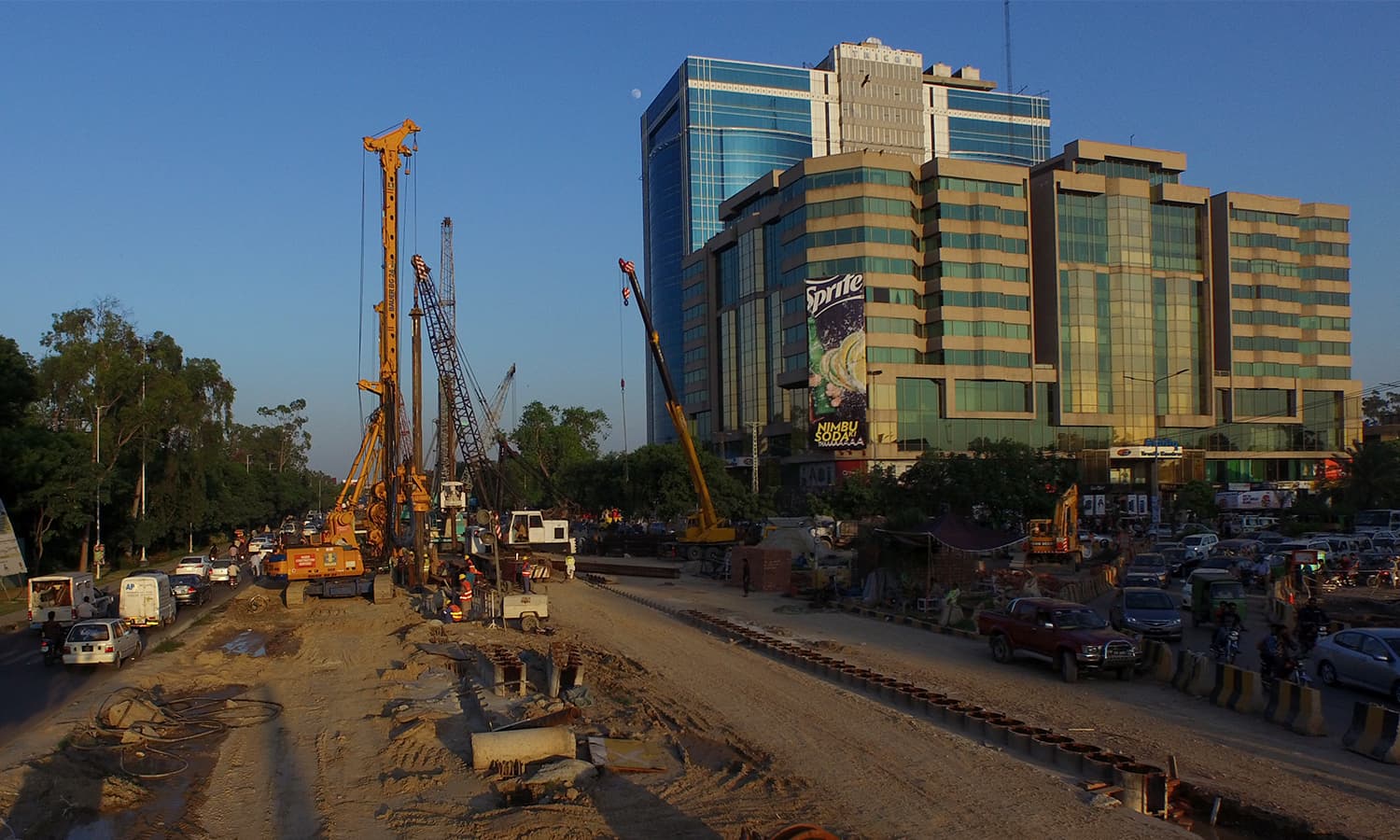
Development projects are usually implemented without factoring environment concerns. —Photo by the author
Unsustainable development
While the city has seen a surge in development projects, they are usually implemented without factoring environment concerns. One such example is the Thokar Niaz Baig flyover, which was built to ease traffic congestion. According to Rafay Alam, an environmental lawyer, surveys have shown the road is not being used to its full capacity.
The Jail Road underpass is a similar case. During a public hearing, a consulting engineer of the Lahore Development Authority (LDA) confessed that the underpass was ill-planned and should be dismantled; a new underpass based on rules and regulations should be rebuilt. He suggested the project’s chief engineer be penalised for allowing construction on an incorrect course and wasting millions of rupees spent by the government.
With Lahore’s population increasing by the day, housing schemes have become a necessity. But these grand construction plans reduce the amount of land that could potentially be used for planting trees. Since there is no law which stops conversion of prime agricultural lands for housing or commercial purposes, the loophole is widely exploited by land developers. One must not ignore the fact that when unplanned housing schemes are constructed, the cost of building roads and other infrastructure is once again dumped on the government’s shoulders.
Medical practitioners have also testified that an increase in the number of concrete structures leads to an increase in temperature, causing sun strokes among pedestrians and motorcyclists during the summer.
Dr. Farzana Anees is a senior medical officer at Gulab Devi Chest Hospital. “We have noted many cases of sun stroke and dehydration in June and July, because of less shade in the city,” she says. Temperature rise is not something people associate with concrete footpaths, but like other development measures, environmental degradation directly affects human health.
There is an immediate need to develop tier two cities to reduce migration to the provincial capital, and to shift our focus from constructing housing schemes to developing green zones.
Green havens during heatwaves
Lahore has only three per cent of green area, which is continuously being paved to make room for roads and buildings. “Our government gives the lowest priority to urban green spaces,” complains Lt. Col. (R) Ejaz Nazim, a senior landscape designer and an environmental activist.The world standard requires a minimum of 25 to 30 per cent of green open space in urban areas—cities like Berlin boast upto 45 per of urban forest cover.
Unpaved green belts also fall under green areas across the city and have great environmental importance. They help in storm water drainage and act as recharge zones for groundwater replenishment. Today, when most green belts have been turned into concrete, groundwater recharge is affected and is witnessing a sharp decline. This may hold little importance for city dwellers travelling in air-conditioned cars, but for less privileged members of society like pedestrians, vendors and cyclists, it is a matter of great concern.
Some delicate trees are planted to monitor levels of air pollution in urban areas, while others help mitigate the negative impacts of air pollution. It is important, therefore, for trees to be planted with awareness of their purpose and function (or lack of).

The 1,500 deaths caused by an unanticipated heat wave in Karachi could have been prevented by the presence of more parks, green belts and urban forest cover in the city. Greenery and trees help to absorb much of the heat, and establishment of green zones can improve a city’s micro-climate, lowering its average temperatures. —Photo by the author
The ignorance of the connection between climate change and urbanisation has already resulted in damage. In Karachi for example, the 1,500 deaths caused by an unanticipated heat wave could have been prevented by the presence of more parks, green belts and urban forest cover in the city.
Greenery and trees help to absorb much of the heat, and establishment of green zones can improve a city’s micro-climate, lowering its average temperatures.
The destruction of gardens
The garden of Mirza Kamran, built by the Mughal of the same name, was once a fantastic sight next to River Ravi in Lahore. Today the garden lies in ruins. If the Mughals were alive, they would be disappointed by the renovations and encroachments that have destroyed their majestic legacies.
The Shalimar Gardens located northeast of the city are also severely affected by development projects. A flyover being built right above the gardens threatens to encroach upon its space, and poses dangers to the centuries’ old gardens.
Then there are the lesser-known gardens left behind by the Mughals and the Sikhs: the Garden of Mahabat Khan, Naulakha Garden, Bagh-e-Dara, Anguri Bagh, Gulabi Bagh, Badami Bagh, Gardens of Raja Teja Singh in Chah Miran, Garden of Raja Dina Nath on Shalimar Road, Garden of Bhai Maha Singh near Shah Alam Gate; all of these have been lost because of unsustainable development. The blame lies squarely upon the government.
During the British era, gardens like the Lahore Zoological Gardens, Anarkali Garden, Manto Park (Iqbal Park) were added to the city. These sites too, are undergoing constant alteration, and are under threat.
Environmental degradation at the Canal
The Lahore Canal road, which stretches over an area of 1,000 acres, is a hotspot for traffic jams. The government’s friendly attitude towards the automobile industry (i.e. less taxation) has led to a surge in vehicles, especially in Lahore and Karachi. In the absence of an efficient public transport network, this has resulted in a population to vehicle ratio that is going out of control. To make matters worse, Lahore’s air pollution levels are already disastrously high, since automobiles lead to an increase in hazardous elements in the atmosphere.
Naseem ur Rehman, the director of the EPD, testifies that air pollution is caused by traffic congestion, which increases particulate matter in air beyond the limits prescribed by WHO. “We need to control the number of automobiles on our roads,” Rehman recommends.
In 2012, a JICA transport study conducted for the government of Punjab over three years found that there were 350,000 automobiles and 850,000 motorcycles in Lahore. It found that 40% of Lahore’s population walks to work; 20% uses motorcycles, 22% uses public transport and 8% uses cars.
The following year, the Canal was declared a protected area under Section 3 of the Lahore Canal Heritage Park Act. The Act banned all construction, clearing, removal, and damage of trees along the canal’s length, but repeated violations of the Act have resulted in extreme environmental degradation.
In a supposedly ingenious move to solve the traffic congestion problem, the government decided to widen the roads along the canal, and cut down the trees. National Engineering Services Pakistan (Pvt) Limited (NESPAK) did not recommend going ahead with this plan, since road-widening is a temporary solution; it may ease up traffic along the Canal briefly, but with the increase in vehicles and poor traffic regulations, a more sustainable plan is required.
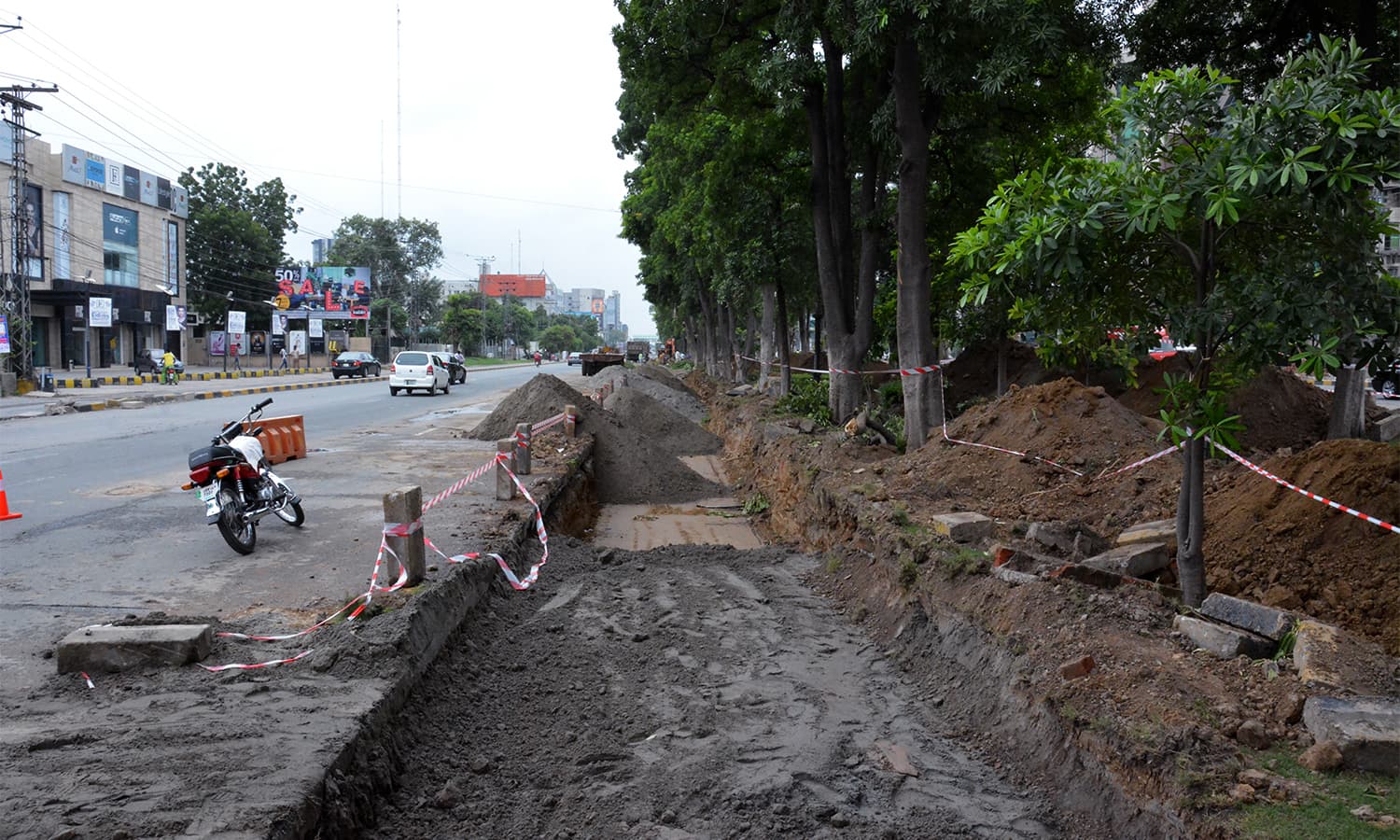
Section 3 of the Lahore Canal Heritage Park Act bans all construction, clearing, removal, and damage of trees along the Canal’s length, but repeated violations of the Act have resulted in extreme environmental degradation. —Photo by the author
Cutting trees, planting trees
“Lahore was once known for its lush green gardens,” says Ijaz, a concerned citizen. “But is now known for its maze of underpasses and overpasses.” Ijaz feels the surge in developmental projects, especially road widening, has taken a toll on the city’s tree cover. The reduction of tree cover around the Canal, specifically, has removed the habitat for many species, including feral cats, small Indian mongoose, Indian monitor lizards, butterflies, fireflies, grey hornbills, yellow-footed green pigeons, white breasted kingfishers and purple sunbirds.
Chopping down trees to widen roads affects both Lahore’s scenic beauty, and the city’s carbon sink, which is a natural or artificial reservoir that helps in removing carbon dioxide from the atmosphere.
But instead of planting more trees to replace the old ones, what little is left of the green belts is being converted into a display of exotic plant species that have less foliage, host no biodiversity, and have little or no shade. On top of it all, they require more attention in pruning and watering, which adds to the burden of the provincial budget. According to a 2007 report by World Bank, unsustainable development and the cutting down of trees is costing Pakistan Rs1 billion rupees every day.
“This was back in 2007,” Nazim observes. “We should think about how much environmental degradation is costing us now.” Nazim, who is also the president of Shajardost Tehreek (Friends of the Trees), does not believe in opposing development plans, but he feels they must be “balanced, sustainable and equitable.”
An exotic, futile hobby
The government’s new hobby to plant exotic species rather than indigenous ones has proved counter-productive for the ecosystem. Exotic plants have little ecological importance for Pakistan since they are alien to the country's climate; unfamiliar species create complications and some prove to be invasive in nature because of their high survival and germination rates. Meanwhile, indigenous species of plants help the ecosystem since they host biodiversity.
“In order to mitigate urban forest cover loss, the government should plant indigenous species of plants,” Z B Mirza recommends. Jaman (black plum), mango, lasura (gum berry), papal and safeeda (eucalyptus) are excellent options, because unlike exotic species, these plants are certain to thrive.
In order to justify their unsustainable development methods, the government has traditionally argued that three times as many trees will be planted to balance out the losses. What the government fails to realise however, is that small exotic plants do not have significant ecological value when compared to large native trees.
Saplings emit less oxygen, have a low survival rate and cannot provide habitat to any species of birds for roosting and nesting. Most importantly, this results in a declining of Lahore’s water table.“Paving green, soft, permeable soil prevents natural recharging of our underground aquifers,” Nazim explains.
Drinking arsenic
Lahore’s groundwater is replenished by River Ravi and rainwater, but the river is already polluted by industrial and municipal waste that contaminates the underground water table. In a report, WWF-Pakistan highlights Lahore’s poor management of Lahore’s water resources. Lahoris, it recommends, should make their water consumption patterns more sustainable, and promote rainwater harvesting—a technique used by several countries to conserve rainwater and its benefits, but one that is unknown in Pakistan.
Rainwater could help raise city’s water table, but most of it goes to waste. Normally, it seeps through vegetation and unpaved areas, recharging the aquifer. But reducing green zones to increase concrete structures means that there are more drains than vegetation, and the rainwater flows into them.
Water samples taken from Jamiya Mosque Haloki, Anwar-e-Madina reveal that water contains twice the minimum arsenic level recommended by the WHO. Government authorities are responsible for the water supplied to these mosques, which is apparently also infused with human waste. This means that safe drinking water – which is a basic human right – is not available to all of Lahore’s population. Medical experts discourage using tap water for drinking purposes since it contains harmful pollutants like lead.
In response to the water crisis, WWF-Pakistan has teamed up with Coca-Cola to install 15 water filtration plants in low-lying areas of the city which lack access to the basic right of clean water supply.
Growing horizontally, not vertically
“Pakistan needs to rethink how it develops its cities,” says Ali Tauqeer Sheikh, the CEO of Leadership for Environment and Development (LEAD) Pakistan and director of Asia, Climate and Development Knowledge Network (CDKN). He feels the problem lies with development taking place “horizontally” rather than “vertically” – which increases the country’s carbon emissions, leads to a loss of fertile land and increases commuting time and cost.
“Cities grow vertically to respond to such challenges,” Sheikh explains. “Lahore is not entering the 21st century [properly]… it is turning into an overgrown village.”

Instead of growing vertically as cities should, Lahore is growing horizontally. —Photo by the author
Sheikh says the growth of industries has led to the construction of sprawling industrial zones in sites which could have been growing basmati rice. “We are compromising our food security by vowing for unsustainable development,” he adds.
Lawyer Ahmed Rafay Alam has some viable solutions. In the absence of sufficient urban forest cover, Alam says the government is destroying the city’s natural environment by building on green zones. “Building new roads might not help reduce traffic, but reducing cars can be the right move,” he suggests. “Meanwhile, we have to stop horizontal expansion.”
For Alam, sustainable development is “low rise, mid-density, mixed-use” and has less harmful impact on the environment. Pakistan, for example, could pick up a few lessons in city-planning from Latin America, where countries have paid the price of unplanned urbanisation.
In the 1960s and 1970s, rural populations rapidly demanded more and more service land, and the planning and development sectors could not deliver. Informal land dealers and developers found an opportunity to expand and grow in the absence of a framework. Cities then grew unplanned, creating issues like traffic congestion, inequality and loss of productivity. It was later proved that the cost of improvement programmes in unplanned urban areas is between three to five times more than the cost of urbanising unoccupied land.
An integrated approach
Our government has become savage and reckless when it comes to protecting the environment. With every tree that falls, every new car emitting carbon into the atmosphere, and every species losing the battle to maintain diversity, our ecosystem is getting weaker. If we are harmed by heat waves, smog, declining water levels and urban flooding, then we are also responsible for it.
We must decide whether we want to protect the environment and lead a healthy lifestyle, which includes healthy food, clean drinking water and refreshing air; or if we want to continue harming it. Cities and urban spaces are centers of development challenges—they might create new opportunities, but experts say the battle against economic collapse, climate change, poverty and health will either be won or lost in cities.
Syed Muhammad Abubakar is an environmental writer with an interest in climate change, deforestation, food security and sustainable development. He tweets @SyedMAbubakar
Fledgingwings
SENIOR MEMBER

- Joined
- Mar 11, 2017
- Messages
- 3,086
- Reaction score
- 0
- Country
- Location
Right ! the common population of lahore.not housing socities for the elite.Bahria Town is always clean and green, no matter which city.
Please post some pics of Mughal Pura, Anarkali, Shadbagh, Ravibagh and other parts of old city to judge how clean Lahore is.
BATMAN
ELITE MEMBER

- Joined
- Mar 31, 2007
- Messages
- 29,887
- Reaction score
- -28
- Country
- Location
Lahore is perfect example of ill planned city.
Politicians and their hired staff at LDA, certainly have no clue of city planning, or any solution for its congestion. All what they are good at is... wasting resources.
Politicians and their hired staff at LDA, certainly have no clue of city planning, or any solution for its congestion. All what they are good at is... wasting resources.
airmarshal
ELITE MEMBER

- Joined
- Jul 28, 2010
- Messages
- 9,354
- Reaction score
- 11
- Country
- Location
Thats only few streets and few roads.
Lahore is among the most polluted, filthy city. Dont fall for this Nooni Toon propaganda. They have this to show after 6 governments in Punjab.
Lahore is among the most polluted, filthy city. Dont fall for this Nooni Toon propaganda. They have this to show after 6 governments in Punjab.
Similar threads
- Replies
- 0
- Views
- 421
- Replies
- 0
- Views
- 591
- Replies
- 1
- Views
- 606
- Replies
- 7
- Views
- 805
